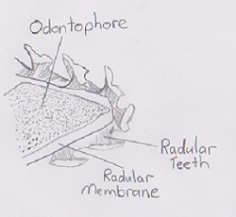Austrocochlea Constricta it is considered a herbivore grazer which emerges at high tide to feed on microalgae, including diatoms and endolithic species that are able to penetrate into the rock surface. Grazing is performed by a structure unique to Molluscs called the Radula, which functions as a scraper for microphagous grazing (Shaw, Macey & Brooker, 2008).
 Figure 1: Illustrates Chitinous Radula teeth erected over the Odontophore
Figure 1: Illustrates Chitinous Radula teeth erected over the Odontophore
The radula is an elongated ribbon-like structure containing rows of small chitinous teeth that have been modified specifically for grazing of microalgae (Shaw, Macey & Brooker, 2008). While A. Constricta is feeding the protractor and retractor muscles which are responsible for the movement of the radula protrude it from the mouth, then work simultaneously to scrape it over the substratum. While this occurs the chitinous teeth cut away food particles which are returned to the buccal cavity.
|